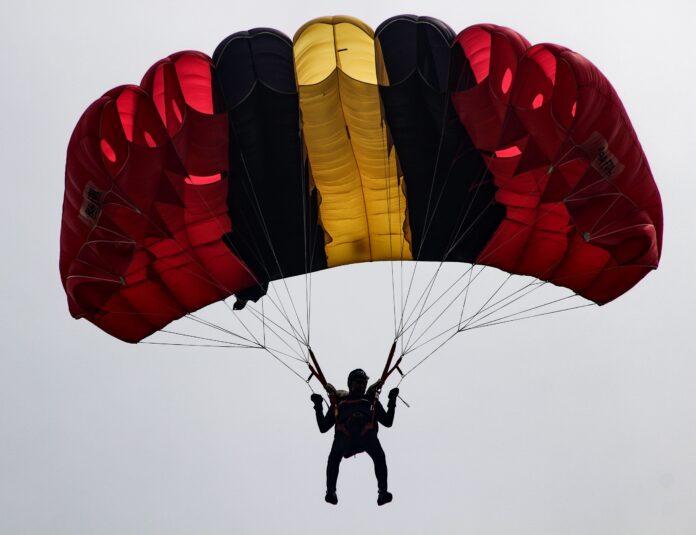Paragliding in India: An exhilarating adventure through the skies
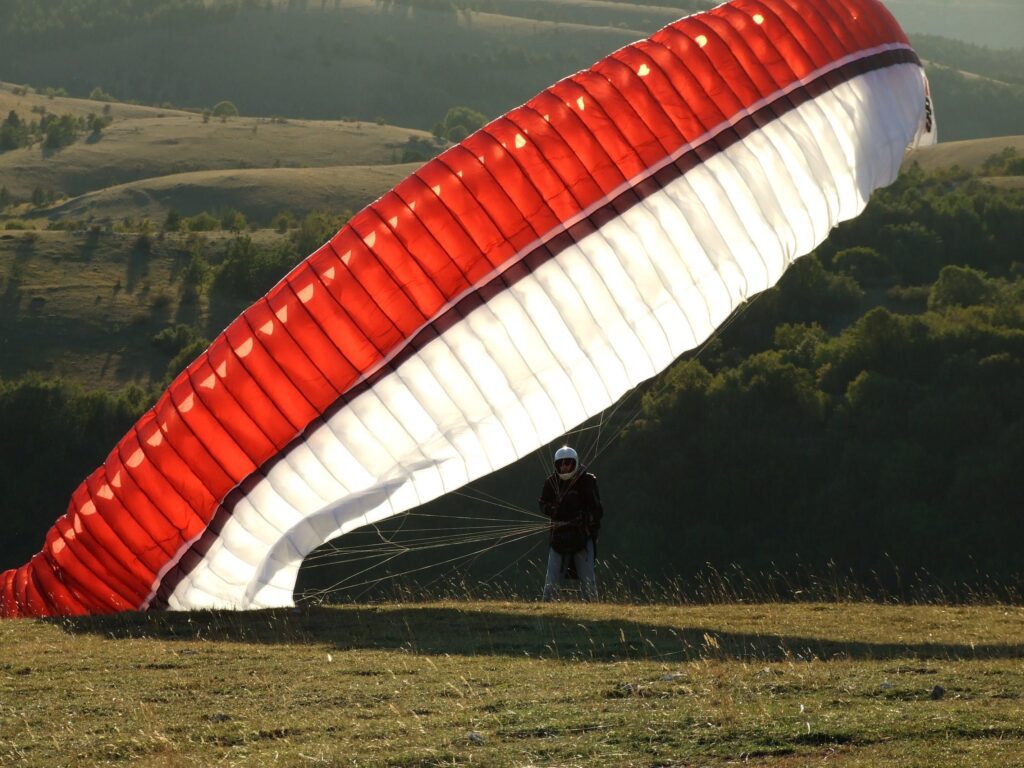
India offers some of the most stunning landscapes and breathtaking views in the world, making it a perfect destination for paragliding enthusiasts. From the snow-capped peaks of the Himalayas to the rolling hills of the south, there are numerous locations to experience the thrill of taking flight.
Here are some of the top destinations for paragliding in India:
1. Bir Billing: Located in Himachal Pradesh, Bir Billing is often referred to as the paragliding capital of India. With its consistent thermal updrafts, long flight times, and beautiful scenery, it’s a haven for both experienced pilots and beginners. The Bir Billing Paragliding Association offers courses and tandem flights for all levels.
2. Manali: Another popular destination in Himachal Pradesh, Manali offers stunning views of the Pir Panjal Range and the Beas River. Paragliding here is typically done from the Rohtang Pass, which provides breathtaking panoramas of the surrounding mountains.
3. Kamshet: Situated near Pune in Maharashtra, Kamshet is known for its pleasant weather and reliable wind conditions. It’s a great place to learn paragliding due to its gentle slopes and experienced instructors. The views of the Sahyadri mountains and the Pawna Lake are simply spectacular.
4. Nainital: Nestled in the Kumaon Hills of Uttarakhand, Nainital offers a unique paragliding experience. You can soar above the picturesque Naini Lake and witness the snow-capped peaks of the Himalayas in the distance. The best time to visit for paragliding is from March to June and September to November.
5. Pavana: Located near Lonavala in Maharashtra, Pavana is a popular spot for paragliding enthusiasts due to its strong winds and stunning views of the surrounding valleys. It’s a great place to experience high-altitude paragliding and enjoy the thrill of flying over the clouds.
6. Nandi Hills: Situated near Bangalore in Karnataka, Nandi Hills offer breathtaking views of the Deccan Plateau. Paragliding here is a relatively new activity, but it’s quickly gaining popularity. The best time to visit for paragliding is from October to February.
7. Munnar: Located in Kerala, Munnar offers stunning views of the Western Ghats and the lush green tea plantations. Paragliding here is a relatively new activity, but it’s quickly gaining popularity. The best time to visit for paragliding is from December to February.
8. Shillong: Located in Meghalaya, Shillong offers breathtaking views of the Khasi Hills and the surrounding valleys. Paragliding here is a relatively new activity, but it’s quickly gaining popularity. The best time to visit for paragliding is from October to March.
9. Gokarna: Located in Karnataka, Gokarna offers stunning views of the Arabian Sea and the surrounding beaches. Paragliding here is a relatively new activity, but it’s quickly gaining popularity. The best time to visit for paragliding is from October to March.
10. Jodhpur: Located in Rajasthan, Jodhpur offers stunning views of the Mehrangarh Fort and the Blue City. Paragliding here is a relatively new activity, but it’s quickly gaining popularity. The best time to visit for paragliding is from October to March.
Things to consider before paragliding in India:
Safety: Always choose a reputable company with experienced and certified instructors.
Weather conditions: The best time for paragliding in India is generally during the dry season, from October to March.
Fitness level: While paragliding is not a physically demanding activity, it’s important to be in good health and have a reasonable level of fitness.
Clothing: Wear comfortable clothing and shoes that you can move freely in.
Insurance: Make sure you have adequate travel insurance that covers paragliding activities.
Paragliding in India can be an exhilarating and unforgettable experience. By following these tips and choosing a reputable company, you can ensure a safe and enjoyable adventure.
Worldwide Paragliding to 10 places
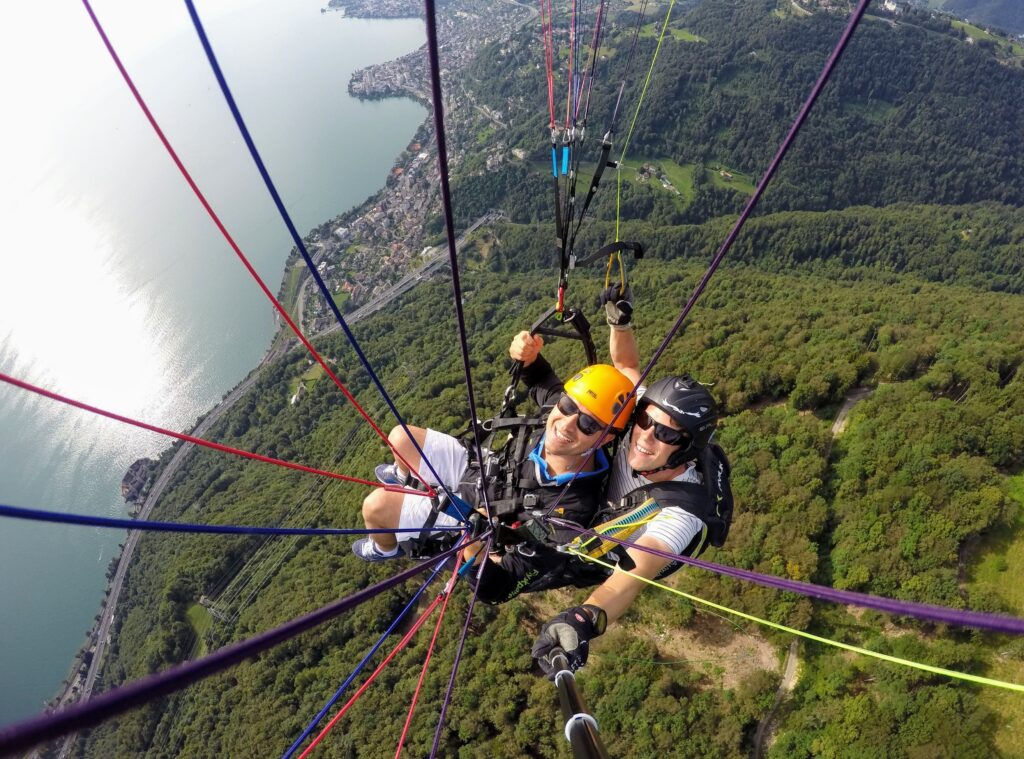
Paragliding Paradise: 10 Breathtaking Destinations Around the World
Paragliding offers a unique and exhilarating way to experience breathtaking landscapes from a bird’s-eye perspective. Soaring above mountains, valleys, and coastlines, you’ll feel a sense of freedom and wonder like never before.
Here are 10 of the best paragliding destinations around the world, each offering something special:
1. Interlaken, Switzerland: Nestled in the heart of the Swiss Alps, Interlaken is renowned for its stunning scenery and world-class paragliding facilities. With majestic mountains like Jungfrau and Eiger as your backdrop, you’ll experience breathtaking views and smooth thermal updrafts.
2. Bir Billing, India: Known as the “paragliding capital of India,” Bir Billing offers year-round flying conditions and spectacular views of the Dhauladhar range. Whether you’re a beginner or a seasoned pro, you’ll find a perfect launch site and experienced instructors in Bir Billing.
3. Pokhara, Nepal: Surrounded by the Annapurna Himalayas, Pokhara offers an unforgettable paragliding experience. Witness the majestic peaks of Machhapuchhre and Annapurna I as you soar above the Phewa Lake and the lush valleys below.
4. Rio de Janeiro, Brazil: Imagine paragliding above the iconic Christ the Redeemer statue and the vibrant city of Rio de Janeiro. This unique experience offers stunning views of Sugarloaf Mountain, Copacabana Beach, and the surrounding coastline.
5. Queenstown, New Zealand: Queenstown, the adventure capital of New Zealand, offers breathtaking paragliding over the Remarkables mountain range and the crystal-clear Lake Wakatipu. Experience the thrill of soaring above vineyards and adventure sports enthusiasts on the ground.
6. Oludeniz, Turkey: The Blue Lagoon of Oludeniz is a world-renowned paragliding destination. Enjoy spectacular views of the turquoise lagoon, white sand beaches, and the dramatic backdrop of Babadağ Mountain.
7. Annecy, France: Nestled between the majestic French Alps and the sparkling Lake Annecy, this city offers breathtaking paragliding opportunities. Glide over medieval castles, charming villages, and the pristine alpine landscape.
8. Chamonix, France: Experience the thrill of flying over the Mont Blanc massif, the highest mountain in Western Europe. Chamonix offers challenging paragliding flights with spectacular views of glaciers, snow-capped peaks, and the picturesque village below.
9. Lake Garda, Italy: Fly like a bird over the stunning Lake Garda, the largest lake in Italy. Enjoy panoramic views of the surrounding vineyards, mountains, and charming villages.
10. Tenerife, Spain: Soar above the volcanic landscapes of Tenerife, the largest Canary Island. Witness the majestic Mount Teide, the highest peak in Spain, and glide over verdant valleys and the picturesque coastline.
Tips for International Paragliding:
- Research and choose reputable paragliding companies with certified instructors.
- Check weather conditions and choose the right time of year for your chosen destination.
- Book your paragliding experience in advance, especially during peak season.
- Get travel insurance that covers paragliding activities.
- Be physically fit and comfortable with heights.
- Dress appropriately for the weather and wear comfortable clothing and shoes.
Paragliding is an incredible adventure that can be enjoyed by people of all ages and experience levels. With careful planning and the right guidance, you can experience the thrill of flight and create lasting memories in some of the world’s most breathtaking locations. So, pack your sense of adventure and get ready to take to the skies!
What is paragliding
Paragliding is an exciting and challenging sport that allows you to experience the joy of flight. It combines the thrill of skydiving with the serenity of gliding, offering a unique way to explore the world from a bird’s-eye view.
Here’s a breakdown of what paragliding is:
Equipment:
Wing: The wing is made of a lightweight, tear-resistant fabric and is shaped like an airfoil. It captures the wind and provides lift, allowing you to stay airborne.
Harness: The harness is a comfortable seat that supports your body and connects you to the wing.
Helmet: A helmet is essential for protecting your head during takeoff and landing.
Reserve parachute: A reserve parachute is a safety device that can be deployed in the event of an emergency.
Flight principles:
Takeoff: Paragliders take off from a hill or mountaintop. The pilot runs forward with the wing inflated, and as soon as they reach sufficient speed, they are lifted into the air.
Flight: Paragliders can stay airborne for hours, depending on the wind conditions and the pilot’s skill. They can fly in thermals, which are rising columns of warm air, or by gliding along ridges and cliffs.
Landing: Paragliders can land in a variety of places, including meadows, beaches, and even parking lots. The pilot controls the descent by adjusting the angle of the wing and using their body weight.
Types of paragliding:
- Recreational: This is the most common type of paragliding. Recreational pilots fly for pleasure and enjoy the views.
- Cross-country: Cross-country pilots fly long distances and compete in races.
- Acro: Acro pilots perform acrobatic maneuvers in the air.
- Vol biv: Vol biv pilots combine paragliding with hiking and camping. They fly to remote locations and stay overnight before flying back.
Benefits of paragliding:
- Stress relief: Paragliding can be a great way to relax and escape the pressures of everyday life.
- Exercise: Paragliding is a good way to get exercise and improve your cardiovascular health.
- Sense of freedom: There’s nothing quite like the feeling of soaring through the air and experiencing the world from a bird’s-eye view.
Paragliding is an amazing sport that can be enjoyed by people of all ages and fitness levels. With proper training and preparation, you can experience the thrill of flight and create memories that will last a lifetime.
How do you paraglide
Paragliding involves launching yourself from a high point and gliding through the air using a large, lightweight wing. Here’s a basic breakdown of how it’s done:
Pre-flight:
- Choose a suitable location: Opt for a hill or mountaintop with clear air and ample space for takeoff and landing.
- Prepare your equipment: Unpack and lay out your wing, harness, helmet, and reserve parachute. Ensure everything is properly connected and adjusted.
- Check the weather conditions: Wind speed and direction, cloud cover, and thermal activity are crucial factors to consider.
- Perform a pre-flight check: Thoroughly inspect your equipment for any tears, rips, or damage.
Taking off:
- Face the wind: Stand with the wing facing into the wind, holding the risers (suspension lines) attached to the harness.
- Run forward: As you gain speed, the wind will inflate the wing above you.
- Continue running: Once the wing catches enough air and you feel lifted, apply gentle pressure to the risers to climb further.
- Maintain proper body position: Keep your body upright and relaxed, with your knees slightly bent and your arms extended.
Flying:
- Control your altitude: To gain altitude, find and ride thermals – rising columns of warm air. To descend, gently pull down on the risers and shift your weight.
- Steer the wing: Use the risers to control the left and right direction of your flight.
- Enjoy the view: Relax and take in the stunning scenery from your unique perspective.
Landing:
- Choose a safe landing spot: Look for a flat, open area with soft ground.
- Approach the landing site: Gently descend towards the ground, maintaining control of the wing.
- Flare the wing: As you get closer to the ground, slowly pull down on the risers to slow your descent.
- Touch down: Aim for a smooth landing on your feet, with your knees slightly bent to absorb the impact.
- Pack up your equipment: Once safely landed, carefully fold and pack away your wing, harness, and other gear.
Paragliding can be a thrilling and rewarding experience, but it’s important to prioritize safety and education. By following these guidelines and seeking proper training, you can enjoy the freedom and beauty of paragliding while minimizing risks.
How much is a paragliding setup
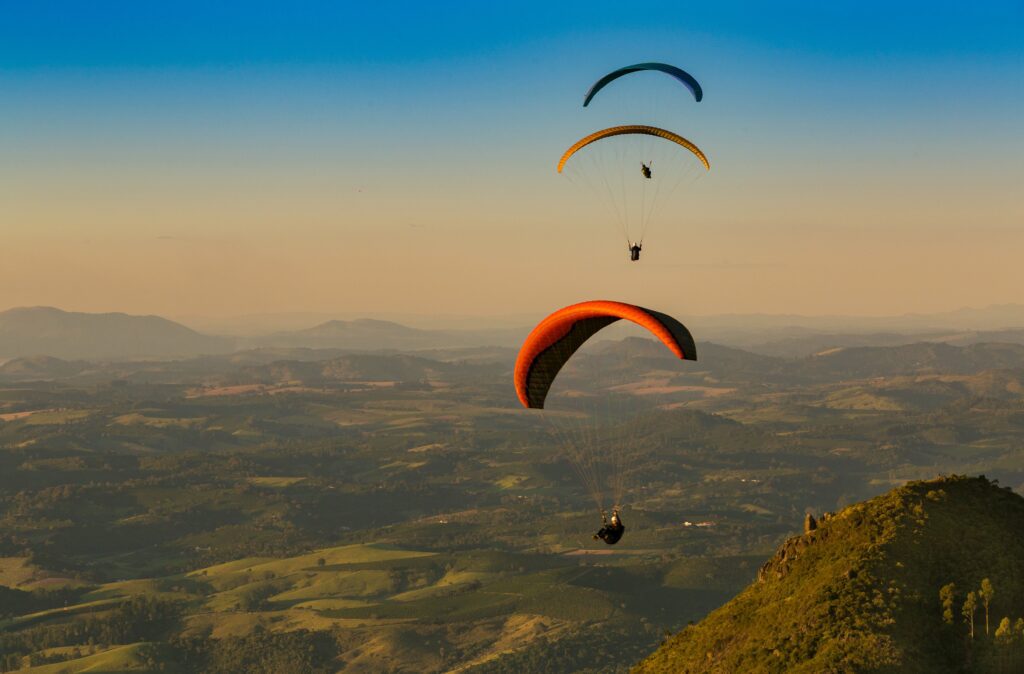
The cost of a paragliding setup can vary widely depending on several factors, including:
1. Type of equipment:
- Wing: Prices can range from $2,500 to $10,000 or more, depending on the level, performance, and brand.
- Harness: Costs typically fall between $500 and $1,000.
- Helmet: Expect to spend $200 to $500 on a good helmet.
- Reserve parachute: This essential safety equipment can cost $800 to $1,500.
- Other accessories: Additional items like instruments, variometers, and GPS trackers can add $500 to $1,000 or more.
2. Brand and quality: Higher-quality equipment from well-known brands will generally be more expensive than budget options.
3. Your level of experience: Beginner pilots might choose to start with a lower-cost setup and upgrade as they gain experience.
4. Location: Prices may vary depending on the region and availability of equipment.
Here’s a rough breakdown of the total cost you can expect:
- Beginner setup: $2,500 to $5,000
- Intermediate setup: $5,000 to $7,500
- Advanced setup: $7,500 and above
Additional costs:
- Lessons: Paragliding lessons are essential for learning proper techniques and ensuring safety. Expect to pay $100 to $200 per lesson.
- Insurance: Consider getting liability insurance to protect yourself in case of accidents.
- Transportation: Factor in the cost of traveling to launch sites and retrieving your gear.
- Maintenance: Regular maintenance and inspections are crucial for keeping your equipment in good condition.
Here are some resources to help you compare prices and find the best deals:
- Online retailers: Many online retailers sell paragliding equipment, offering a wide range of brands and prices.
- Used gear: Purchasing used equipment can be a more affordable option, but ensure it is in good condition and certified by a qualified professional.
- Paragliding schools: They often sell new and used equipment at competitive prices.
Remember, investing in quality equipment and proper training is crucial for safe and enjoyable paragliding experiences. Don’t compromise on safety for the sake of saving a few dollars.
What Types Government Permissions Required For Paragliding
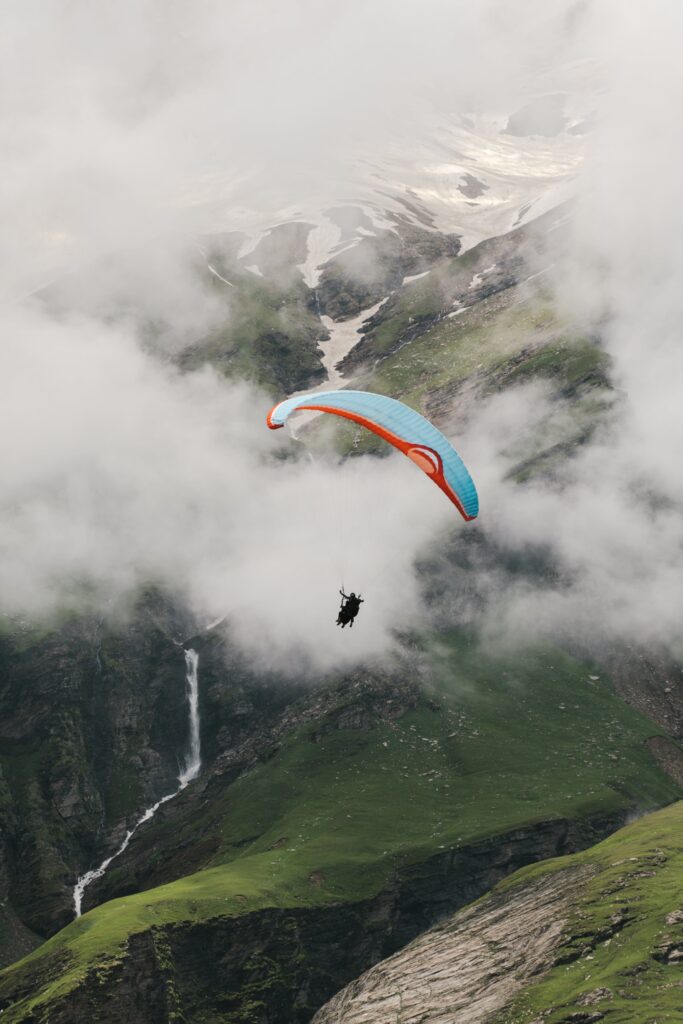
The government permissions required for paragliding can vary depending on the specific location and regulations. However, some general permissions and considerations are often applicable:
1. Flight Permits:
Civil Aviation Authority (CAA): Most countries require a permit from the national Civil Aviation Authority (CAA) to operate paragliders. This permit may require specific qualifications, registration of the paraglider, and adherence to safety regulations.
Local Authorities: Depending on the region, additional permits may be required from local authorities such as national parks, forests, or paragliding clubs.
2. Pilot Certification:
Paragliding License: In many countries, obtaining a paragliding license is mandatory before flying solo. This license typically involves completing a training course, passing theoretical and practical exams, and demonstrating proficiency in safe flying techniques.
Medical Clearance: A medical examination may be required to confirm your fitness for paragliding.
3. Insurance:
Liability Insurance: Liability insurance is crucial to protect yourself and others in case of accidents. Most countries require paragliding pilots to have adequate liability insurance.
4. Site-Specific Regulations:
Landowner Permission: Obtaining permission from the landowner is necessary if you plan to launch or land on private property.
Restricted Airspace: Be aware of restricted airspace zones where paragliding might be prohibited or require special authorization.
Environmental Considerations: Paragliding activities should comply with local environmental regulations and avoid disturbing wildlife or protected areas.
5. Additional Documentation:
ID and Proof of Address: Carry valid identification documents and proof of address for verification purposes.
Logbook: Maintaining a logbook to record your flights and experience is recommended for tracking progress and meeting licensing requirements.
Here are some resources to help you understand the specific government permissions required for paragliding in your location:
National Civil Aviation Authority (CAA) website: The CAA website usually provides information about regulations, licensing requirements, and permitted flying areas.
Paragliding Associations: Local or national paragliding associations can offer guidance and resources on regulations, permissions, and safe flying practices.
Online Forums and Communities: Online forums and communities dedicated to paragliding can provide valuable insights from experienced pilots and updates on regulations.
Remember, it’s crucial to research and understand the specific regulations and permissions required for paragliding in your chosen location. Always comply with all applicable laws and prioritize safety by adhering to established guidelines and best practices.
What is surfing and paragliding
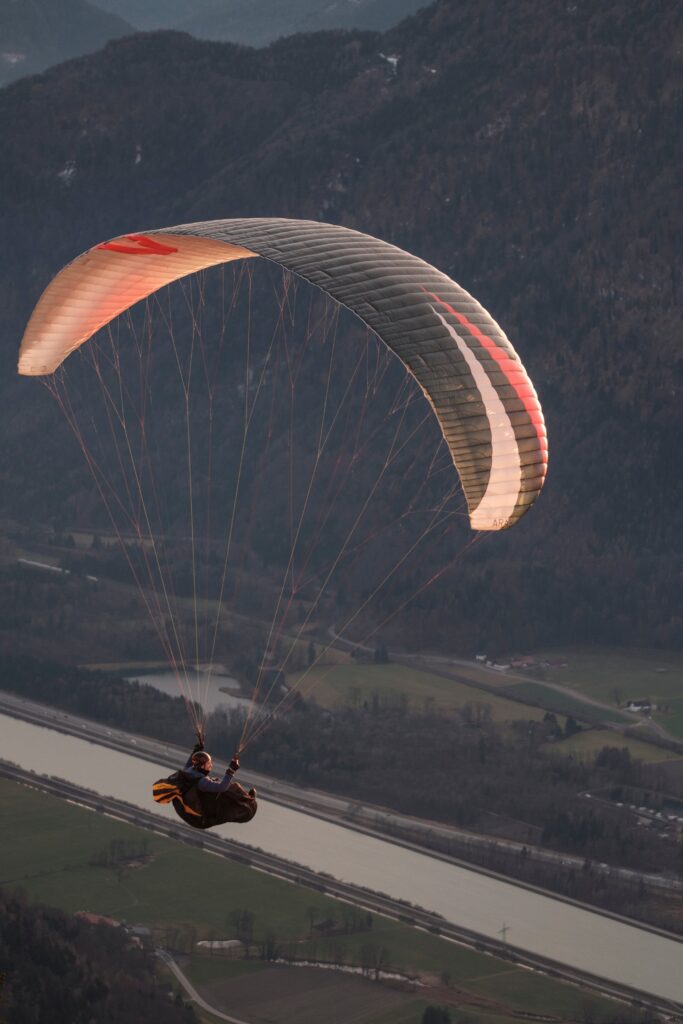
Surfing and Paragliding: Two Thrilling Adventures
Surfing and paragliding are two completely different activities, yet both offer exhilarating experiences and breathtaking views. Here’s a breakdown of each:
Surfing:
Description: Surfing involves riding waves on a surfboard. The surfer paddles out to the waves, waits for a suitable wave to break, and then stands up on the board to ride the wave towards the shore.
Required Equipment:
Surfboard
Leash
Wetsuit (optional)
Sunscreen
Benefits:
Full-body workout
Improves balance and coordination
Provides a sense of accomplishment
Connects you with nature
Challenges:
Requires physical fitness
Can be difficult to learn
Can be dangerous in rough conditions
Paragliding:
Description: Paragliding involves gliding through the air using a large, lightweight wing. The paraglider takes off from a high point and uses thermals (rising columns of warm air) to stay airborne.
Required Equipment:
Paraglider
Harness
Helmet
Reserve parachute
Benefits:
Breathtaking views
Feeling of freedom and weightlessness
Relaxation and stress relief
Unique perspective of the world
Challenges:
Can be expensive to get started
Requires training and certification
Can be risky if not done safely
Here’s a table summarizing the key differences between surfing and paragliding:
| Feature | Surfing | Paragliding |
|---|---|---|
| Activity: | Riding waves | Gliding through the air |
| Equipment: | Surfboard, leash, wetsuit | Paraglider, harness, helmet, reserve parachute |
| Benefits: | Full-body workout, balance & coordination, accomplishment, connection to nature | Breathtaking views, freedom & weightlessness, relaxation, unique perspective |
| Challenges: | Physical fitness, learning curve, rough conditions | Expense, training & certification, risk |
Ultimately, the best activity for you depends on your personal preferences, physical capabilities, and budget. Both surfing and paragliding offer unique thrills and opportunities to experience the outdoors in an unforgettable way.
is paragliding safe
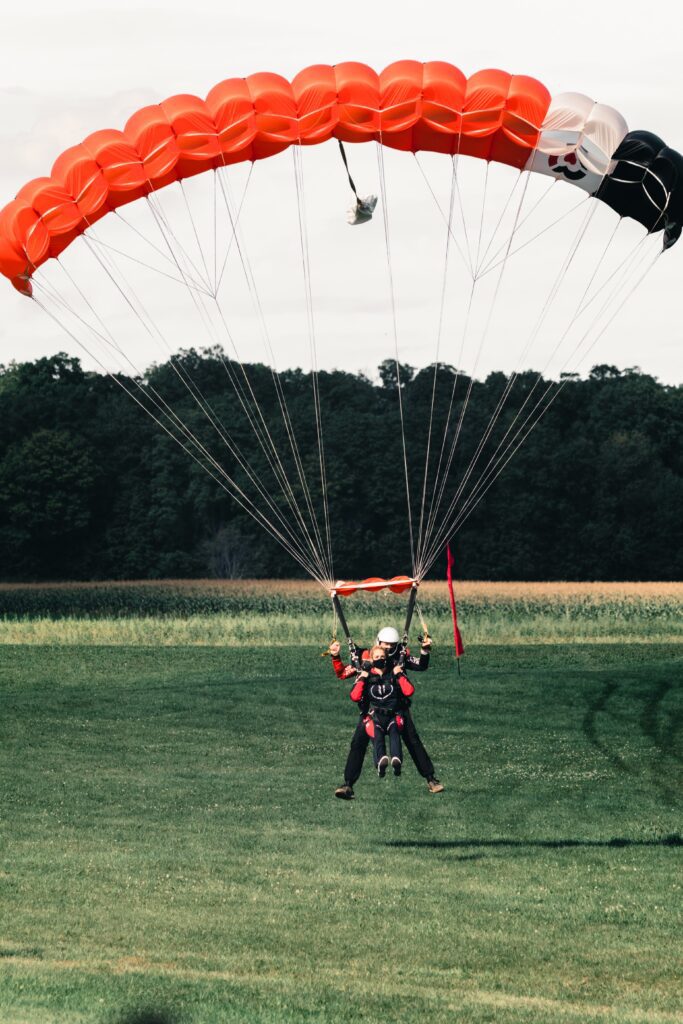
Paragliding can be a safe activity if proper precautions are taken. However, like any activity that involves heights and wind, there are inherent risks involved. Here’s a breakdown of the safety aspects of paragliding:
Safety Measures:
Training and Certification: Completing a paragliding course from a reputable school and obtaining the necessary certification is crucial. This ensures you have the proper knowledge and skills to fly safely.
Equipment Maintenance: Regularly inspecting and maintaining your paraglider, harness, helmet, and other equipment is essential to ensure they are in good working condition.
Weather Conditions: Always check the weather forecast before flying and only fly in suitable conditions. Avoid flying in strong winds, rain, or thunderstorms.
Choosing Your Location: Select safe launch and landing sites with clear airspace and sufficient space.
Flying with Others: Fly with an experienced pilot or instructor, especially as a beginner.
Following Safety Rules: Adhere to all established paragliding regulations and safety guidelines.
Carrying Safety Equipment: Always carry a reserve parachute and first-aid kit.
Physical Fitness: Being in good physical health and maintaining situational awareness while flying contribute significantly to safety.
Risks and Statistics:
Accidents: While rare, accidents can happen during paragliding due to weather incidents, pilot error, equipment failure, or other unforeseen circumstances.
Fatality Rates: Compared to other extreme sports, paragliding has a relatively low fatality rate. According to the United States Hang Gliding and Paragliding Association (USHPA), the average annual fatality rate in the US is around 0.0074% for paragliding and 0.0004% for skydiving.
Injuries: Minor injuries like sprains, bruises, and cuts are more common than fatalities in paragliding accidents.
Safety Tips for Paragliding:
- Never fly alone, especially as a beginner.
- Start with small, controlled flights and gradually progress as you gain experience.
- Be aware of your surroundings and potential hazards.
- Always wear proper safety gear, including a helmet and reserve parachute.
- Listen to your body and don’t push yourself beyond your limits.
- Fly within your skill level and choose appropriate flight zones.
- Respect the environment and be courteous to other airspace users.
- Never fly under the influence of alcohol or drugs.
Overall, paragliding can be a safe and enjoyable activity when approached with caution and a commitment to safety. By taking the necessary precautions and following established guidelines, you can minimize the risks and experience the thrill of soaring through the skies.
Here are some resources for further information about paragliding safety:
- United States Hang Gliding and Paragliding Association (USHPA): https://www.ushpa.org/
- British Hang Gliding and Paragliding Association (BHPA): https://www.bhpa.co.uk/
- Fédération Aéronautique Internationale (FAI): https://www.fai.org/
Remember, safety should always be your top priority when paragliding. By taking the right precautions and preparing adequately, you can minimize risks and experience the joy of flight in a safe and responsible way.
Paragliding Big Accidents in India
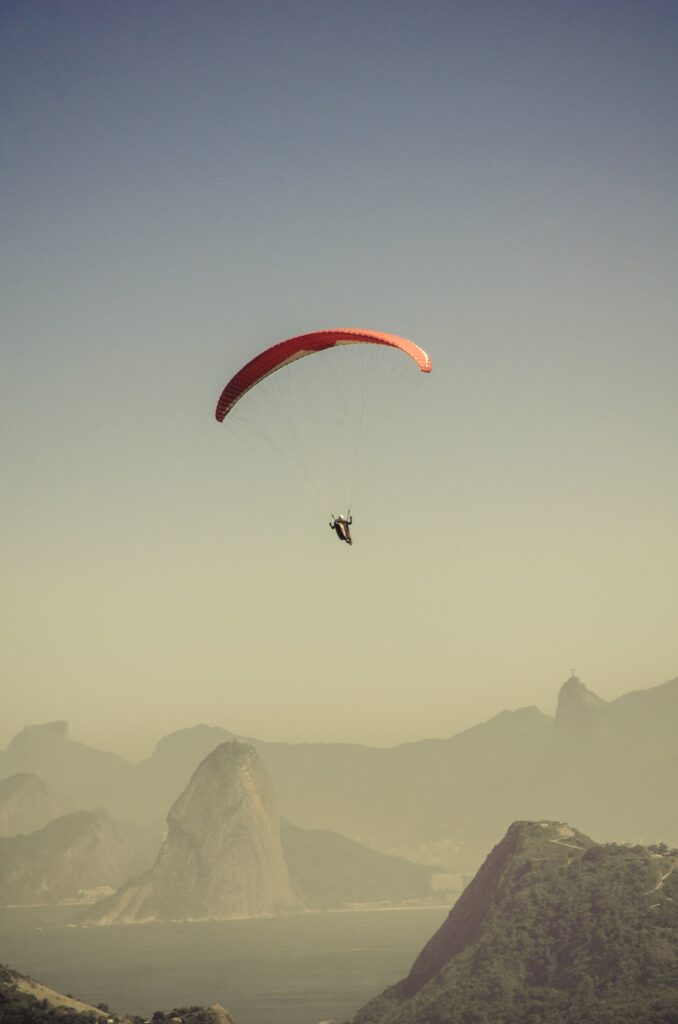
While paragliding is a generally safe activity when properly practiced and supervised, accidents have unfortunately occurred in India. Here are some notable instances:
2023:
- July: Two tourists were injured while paragliding in Himachal Pradesh’s Bir Billing. The incident was reportedly due to a sudden change in wind direction.
- May: A 30-year-old tourist from Maharashtra died after falling hundreds of feet while paragliding in Kullu district, Himachal Pradesh. Initial reports suggest the harness malfunctioned.
- February: A paragliding tandem flight in Himachal Pradesh resulted in the death of one passenger and serious injury to another. The cause of the accident is still under investigation.
2022:
- October: A paragliding instructor died after his wing collapsed during a flight in Himachal Pradesh.
- July: A 12-year-old boy died after falling from a height while paragliding in Himachal Pradesh. The incident sparked concerns about safety standards and regulations in the region.
2021:
- September: Two tourists were injured after their paraglider crashed near Manali, Himachal Pradesh.
- May: A 22-year-old woman died after her paraglider collided with another in Bir Billing, Himachal Pradesh.
2020:
- February: A 32-year-old tourist died after falling from a paraglider in Munnar, Kerala.
- January: A paragliding instructor died during a tandem flight in Bir Billing, Himachal Pradesh.
Analysis:
- Many accidents occur in Himachal Pradesh, a popular paragliding destination in India.
- Equipment failure, pilot error, and sudden changes in weather conditions are often contributing factors.
- Safety concerns have been raised about the lack of regulations and training standards in the paragliding industry in India.
Authorities have implemented some safety measures, such as:
- Mandating licenses for pilots and instructors.
- Requiring regular equipment inspections.
- Setting regulations for weather conditions and permissible flying areas.
- However, concerns remain regarding the enforcement of these regulations and the overall safety culture in the paragliding industry.
It is crucial for participants to choose reputable paragliding companies with certified pilots and well-maintained equipment. They should also be aware of the risks involved and ensure they understand the safety protocols before taking flight.
How much does it cost to get into paragliding
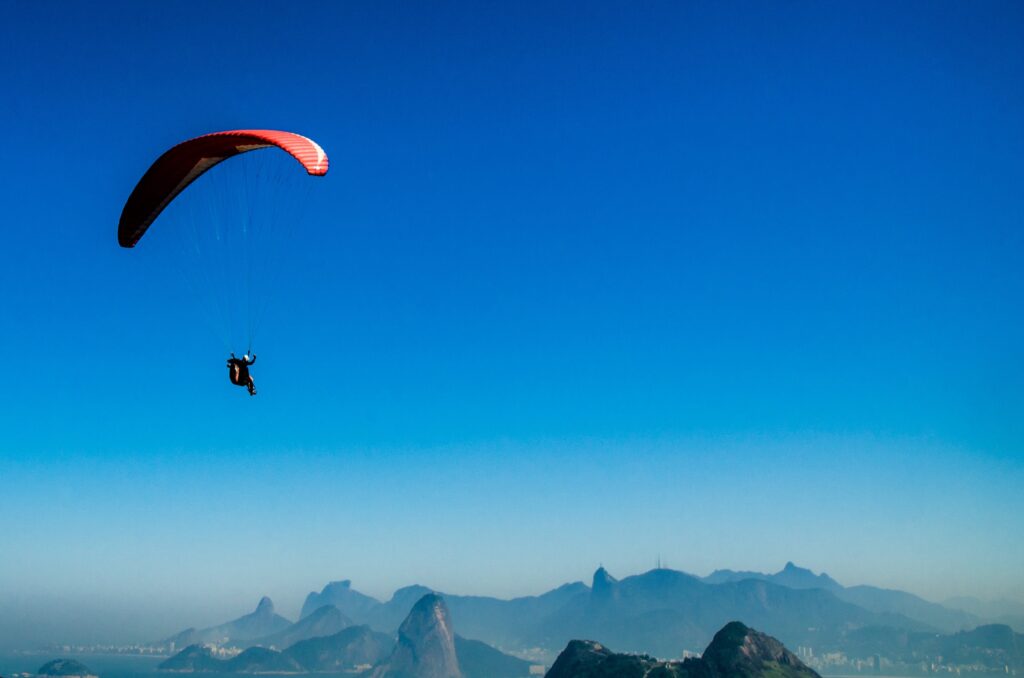
The cost of getting into paragliding can vary significantly depending on several factors, including:
1. Location:
Region: Prices can differ between countries and even within regions due to variations in equipment availability, training costs, and operational expenses.
Flying Site Fees: Some paragliding sites charge access or launch fees.
2. Equipment:
New vs. Used: Buying new equipment is generally more expensive than purchasing used gear. However, it ensures you have reliable and well-maintained equipment.
Type of Equipment: Beginner-level equipment tends to be cheaper than advanced gear used by experienced pilots.
Brand and Quality: Renowned brands with high-quality materials and construction will command premium prices.
3. Training:
Course Length and Intensity: Longer and more intensive courses are typically more expensive.
Certification Level: Different certifications require varying levels of training and incur different costs.
Instructor Experience and Qualifications: Experienced and certified instructors often charge higher rates.
4. Additional Costs:
Transportation: Traveling to launch sites and retrieving your equipment can require transportation costs.
Insurance: Liability insurance is crucial and adds to the overall expense.
Membership fees: Some paragliding clubs or associations have membership fees.
Here’s a rough breakdown of the cost range to get started with paragliding:
Beginner:
Equipment: $4,000 – $6,000
Training: $1,000 – $2,000
Additional Costs: $500 – $1,000
Total: $5,500 – $9,000
Intermediate:
Equipment: $6,000 – $8,000
Training: $2,000 – $3,000
Additional Costs: $1,000 – $1,500
Total: $9,000 – $12,500
Advanced:
Equipment: $8,000 – $12,000+
Training: $3,000 – $4,000+
Additional Costs: $1,500 – $2,000+
Total: $13,000 – $18,000+
Cost of Getting into Paragliding by Location:
| Location | Equipment | Training | Additional Costs | Total (Approx.) |
|---|---|---|---|---|
| Manali, India | ₹30,000 – ₹50,000 | ₹10,000 – ₹20,000 | ₹5,000 – ₹10,000 | ₹45,000 – ₹80,000 |
| Bir Billing, India | ₹25,000 – ₹45,000 | ₹8,000 – ₹15,000 | ₹5,000 – ₹10,000 | ₹38,000 – ₹70,000 |
| Kamshet, India | ₹20,000 – ₹40,000 | ₹8,000 – ₹15,000 | ₹4,000 – ₹8,000 | ₹32,000 – ₹63,000 |
| Vagamon, India | ₹25,000 – ₹45,000 | ₹8,000 – ₹15,000 | ₹5,000 – ₹10,000 | ₹38,000 – ₹70,000 |
| Goa, India | ₹20,000 – ₹40,000 | ₹8,000 – ₹15,000 | ₹4,000 – ₹8,000 | ₹32,000 – ₹63,000 |
| Sikkim, India | ₹35,000 – ₹55,000 | ₹10,000 – ₹20,000 | ₹5,000 – ₹10,000 | ₹50,000 – ₹85,000 |
Note:
These costs are approximate and can vary depending on various factors like equipment brand, training provider, additional services, and season.
The equipment cost includes a paraglider, harness, helmet, and reserve parachute.
Additional costs may include transportation, accommodation, food, insurance, and club memberships.
Always research and compare prices before making any purchase or booking a training course.
Remember that these are just estimates, and the actual cost can vary depending on your specific choices and location.
Ultimately, the cost of getting into paragliding should not deter you from experiencing the thrill of flight. By researching your options and planning your budget, you can find a way to make this exciting sport accessible.
Paragliding Legal in India
The legal status of paragliding in India is currently complex and somewhat ambiguous.
Here’s a breakdown of the situation:
1. Lack of Specific Regulations:
Unlike many other countries, India lacks a comprehensive legal framework specifically governing paragliding.
While the Civil Aviation Act, 1934, and the Aircraft Rules, 1937, provide general regulations for air navigation, they don’t explicitly address paragliding.
2. Regulatory Patchwork:
Different states and local authorities have implemented their own regulations and guidelines for paragliding to varying degrees.
This patchwork approach creates inconsistencies and confusion for pilots and operators.
3. Licensing and Permits:
The Paragliding Association of India (PAI) offers a voluntary licensing system for pilots and instructors.
However, this system lacks legal enforcement and is not recognized by all authorities.
Some states require permits for commercial paragliding operations, while others don’t.
4. Unregulated Areas:
Many popular paragliding sites in India operate without proper regulations or safety oversight.
This lack of control increases the risk of accidents and hinders the development of a responsible paragliding culture.
5. Efforts for Regulation:
The Directorate General of Civil Aviation (DGCA) has been working on a draft regulation specifically for paragliding.
However, the finalization and implementation of this regulation are yet to be completed.
In conclusion, while paragliding is not explicitly prohibited in India, the lack of a clear legal framework and inconsistent enforcement create challenges for safe and responsible practice.
should also choose reputable and certified operators and ensure they understand the safety protocols before taking flight.
Paragliding famous places in india
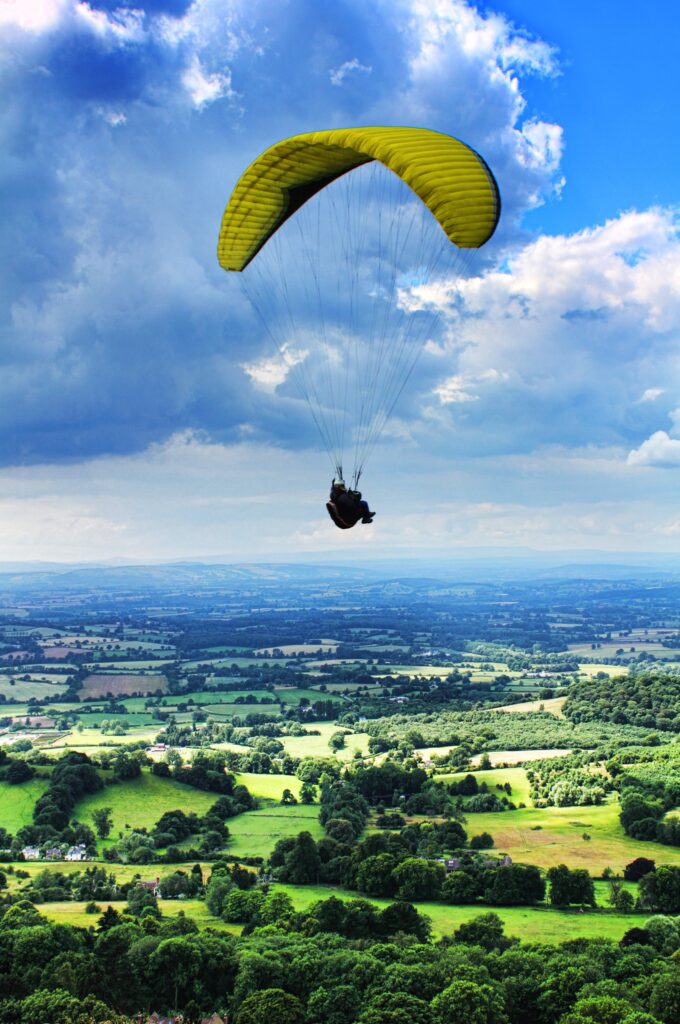
India boasts a diverse landscape with stunning mountain ranges and coastal cliffs, making it a haven for paragliding enthusiasts. Here are some of the most famous paragliding places in India:
Himachal Pradesh:
Bir Billing: Renowned as the Paragliding Capital of India, Bir Billing offers year-round flying opportunities with breathtaking views of the Dhauladhar mountain range.
Manali: This picturesque hill station provides a thrilling paragliding experience with panoramic views of snow-capped peaks and lush valleys.
Solang Valley: Known for its adventure sports, Solang Valley offers tandem paragliding flights over scenic landscapes.
Kullu Valley: Paraglide over the stunning Kullu Valley, experiencing the grandeur of the Himalayas and the Beas River.
Maharashtra:
Kamshet: This popular destination near Mumbai offers year-round paragliding with scenic views of the Sahyadri mountains and the Pawna lake.
Naneghat: Experience a unique paragliding adventure over the ancient Naneghat pass, surrounded by historical forts and lush greenery.
Karnataka:
Nandi Hills: Paraglide over the Nandi Hills, enjoying panoramic views of Bangalore city and the surrounding countryside.
Chikmagalur: Fly above the coffee plantations and rolling hills of Chikmagalur, experiencing the natural beauty of the Western Ghats.
Other Notable Locations:
Vagamon, Kerala: Paraglide over the lush hills and valleys of Vagamon, known for its waterfalls and serene atmosphere.
Goa: Enjoy a coastal paragliding experience over the beaches and turquoise waters of Goa.
Munnar, Kerala: Paraglide over the tea plantations and picturesque landscapes of Munnar, offering breathtaking views of the Western Ghats.
Sikkim: Experience the thrill of paragliding in the Himalayas, with stunning views of Mount Kanchenjunga and the surrounding peaks.
| Region | Location | Description | Price Range | Additional Details |
|---|---|---|---|---|
| Himachal Pradesh | Bir Billing | Paragliding Capital of India, year-round flying, breathtaking Dhauladhar views | ₹4,000 – ₹8,000 (tandem) | Renowned for long flights, competitions, and training schools. |
| Himachal Pradesh | Manali | Picturesque, thrilling flights with snow-capped peaks and lush valleys | ₹4,500 – ₹9,000 (tandem) | Diverse terrains, suitable for beginners and experienced pilots. |
| Himachal Pradesh | Solang Valley | Adventure sports hub, tandem flights over scenic landscapes | ₹5,000 – ₹10,000 (tandem) | Popular for short, scenic flights and breathtaking views. |
| Himachal Pradesh | Kullu Valley | Paragliding over the stunning Kullu Valley, experiencing the Himalayas and the Beas River | ₹4,000 – ₹8,000 (tandem) | Offers panoramic views and diverse flying experiences. |
| Maharashtra | Kamshet | Year-round flying near Mumbai, scenic Sahyadri mountains and Pawna lake views | ₹3,500 – ₹7,000 (tandem) | Easily accessible from Mumbai, suitable for beginners and experienced pilots. |
| Maharashtra | Naneghat | Unique experience over the ancient Naneghat pass, forts and lush greenery | ₹6,000 – ₹12,000 (tandem) | Historical significance, challenging terrain for experienced pilots. |
| Karnataka | Nandi Hills | Paraglide over Nandi Hills, panoramic views of Bangalore city and the countryside | ₹4,000 – ₹7,000 (tandem) | Close to Bangalore, offers scenic flights and sunset experiences. |
| Karnataka | Chikmagalur | Fly above coffee plantations and rolling hills, Western Ghats beauty | ₹5,000 – ₹9,000 (tandem) | Serene atmosphere, suitable for both beginners and experienced pilots. |
| Kerala | Vagamon | Lush hills and valleys, waterfalls, serene atmosphere | ₹4,000 – ₹8,000 (tandem) | Offers both short and long flights, ideal for relaxation and scenic views. |
| Goa | Coastal paragliding experience over beaches and turquoise waters | ₹4,500 – ₹9,000 (tandem) | Unique coastal perspective, suitable for all experience levels. | |
| Kerala | Munnar | Paraglide over tea plantations and picturesque landscapes, Western Ghats views | ₹5,000 – ₹10,000 (tandem) | Breathtaking scenery, diverse flying terrains for all experience levels. |
| Sikkim | Himalayan paragliding experience with stunning views of Mount Kanchenjunga | ₹6,000 – ₹12,000 (tandem) | Challenging terrain for experienced pilots, breathtaking mountain views. |
Remember, the best paragliding location depends on your experience level, preferences, and budget. It’s crucial to research each location’s regulations, weather conditions, and available services before planning your paragliding adventure.
Paragliding Advantage and Disadvantage
Paragliding offers a unique and exhilarating experience, but like any adventure sport, it comes with both advantages and disadvantages.
Advantages:
Breathtaking Views: Paragliding allows you to soar through the air, enjoying stunning panoramic views of mountains, valleys, coastlines, and other landscapes from a completely different perspective.
Sense of Freedom and Weightlessness: The feeling of floating effortlessly through the air is liberating and exhilarating, providing a unique sense of freedom and weightlessness.
Stress Relief and Relaxation: Paragliding can be a great stress reliever and promote relaxation. The peaceful movement through the air and the stunning scenery can help you unwind and escape the worries of daily life.
Physical Activity and Fitness: Paragliding can be a good form of physical activity, engaging your core muscles and improving your balance and coordination.
Connection with Nature: Paragliding allows you to experience nature in a way that is rarely possible on the ground, fostering a deeper appreciation for the environment.
Thrilling Adventure: Paragliding offers an adrenaline rush and a sense of adventure, making it a thrilling and exciting experience.
Accessible to Various Age Groups: Paragliding is relatively accessible to people of different age groups and fitness levels, with options for both beginners and experienced pilots.
Social Aspect: Paragliding can be a social activity, allowing you to connect with other enthusiasts and share your passion for the sport.
Disadvantages:
Safety Risks: Paragliding inherently involves risks, including accidents due to weather conditions, pilot error, or equipment failure.
Cost: The initial investment in equipment and training can be expensive, and ongoing costs for maintenance and insurance can add up.
Weather Dependency: Paragliding is highly dependent on weather conditions, and flights can be cancelled due to wind, rain, or other adverse weather.
Limited Accessibility: Paragliding requires specific launch and landing sites, which may not be readily available in all areas.
Physical Demands: While not necessarily strenuous, paragliding requires some physical fitness and agility, especially for launching and landing.
Learning Curve: Mastering the skills and techniques of paragliding requires dedication and practice, which can take time and effort.
Regulation Issues: Some paragliding locations may have unclear regulations or inconsistencies in safety standards.
Environmental Concerns: Paragliding can have some environmental impact, particularly on sensitive ecosystems and wildlife.
Conclusion:
Paragliding offers a unique and rewarding experience, but it’s important to weigh both the advantages and disadvantages before trying it. By understanding the risks and challenges involved, ensuring your safety, and choosing reputable operators, you can enjoy the thrill of flight and all that paragliding has to offer.
Conclusion
| Aspect | Pros | Cons |
|---|---|---|
| Experience | Breathtaking views, sense of freedom, stress relief, physical activity, connection with nature, thrilling adventure | Safety risks, cost, weather dependency, limited accessibility, physical demands, learning curve |
| Safety | Relatively low fatality rate, safety protocols, equipment standards | Inherent risks, accidents can occur, dependence on pilot skill |
| Cost | Affordable tandem flights, used equipment options | Expensive initial investment, ongoing maintenance and insurance |
| Accessibility | Beginner-friendly, adaptable to different age groups | Limited launch and landing sites, may not be available everywhere |
| Regulation | Voluntary licensing system (PAI), efforts for comprehensive regulations | Lack of clear legal framework, inconsistent enforcement, unregulated areas |
| Environment | Enjoying natural beauty, minimal environmental impact | Potential disturbance to wildlife, impact on sensitive ecosystems |
| Social | Connecting with other enthusiasts, sharing passion | Can be a solitary activity, requires finding communities or groups |
| Overall | Unique and exhilarating experience, promotes well-being, sense of achievement | Requires careful consideration of risks and challenges, commitment to safety and training |
| Recommendation | Choose reputable operators, prioritize safety, research location and regulations, enjoy the journey! | Take precautions, understand limitations, don’t rush into it |
Paragliding in India: A Thrilling Adventure with Diverse Landscapes
India offers a truly unique and exhilarating paragliding experience, with diverse landscapes ranging from snow-capped mountains to lush valleys and stunning coastlines. Whether you’re a seasoned pilot or a curious beginner, India has something to offer everyone. Here are some key points to conclude:
Benefits:
- Breathtaking views and a unique perspective on the world.
- Sense of freedom and weightlessness.
- Stress relief and relaxation.
- Physical activity and fitness benefits.
- Connection with nature and appreciation for the environment.
- Thrilling adventure and adrenaline rush.
- Accessible to various age groups and fitness levels.
- Social aspect and opportunity to connect with other enthusiasts.
Challenges:
- Inherent safety risks requiring careful planning and adherence to safety protocols.
- Initial investment in equipment and ongoing costs for maintenance and insurance.
- Dependence on weather conditions and potential for cancellations.
- Limited accessibility with specific launch and landing sites.
- Learning curve requiring dedication and practice.
- Lack of a clear legal framework in some areas necessitates research and choosing reputable operators.
- Environmental concerns regarding potential impact on wildlife and sensitive ecosystems.
Overall:
Paragliding in India offers an unforgettable experience with breathtaking views, a sense of freedom, and a thrilling adventure. However, it’s important to acknowledge the inherent risks and challenges, prioritize safety, and choose reputable operators. With careful planning and a commitment to responsible practices, paragliding in India can be a safe and rewarding experience for everyone.
